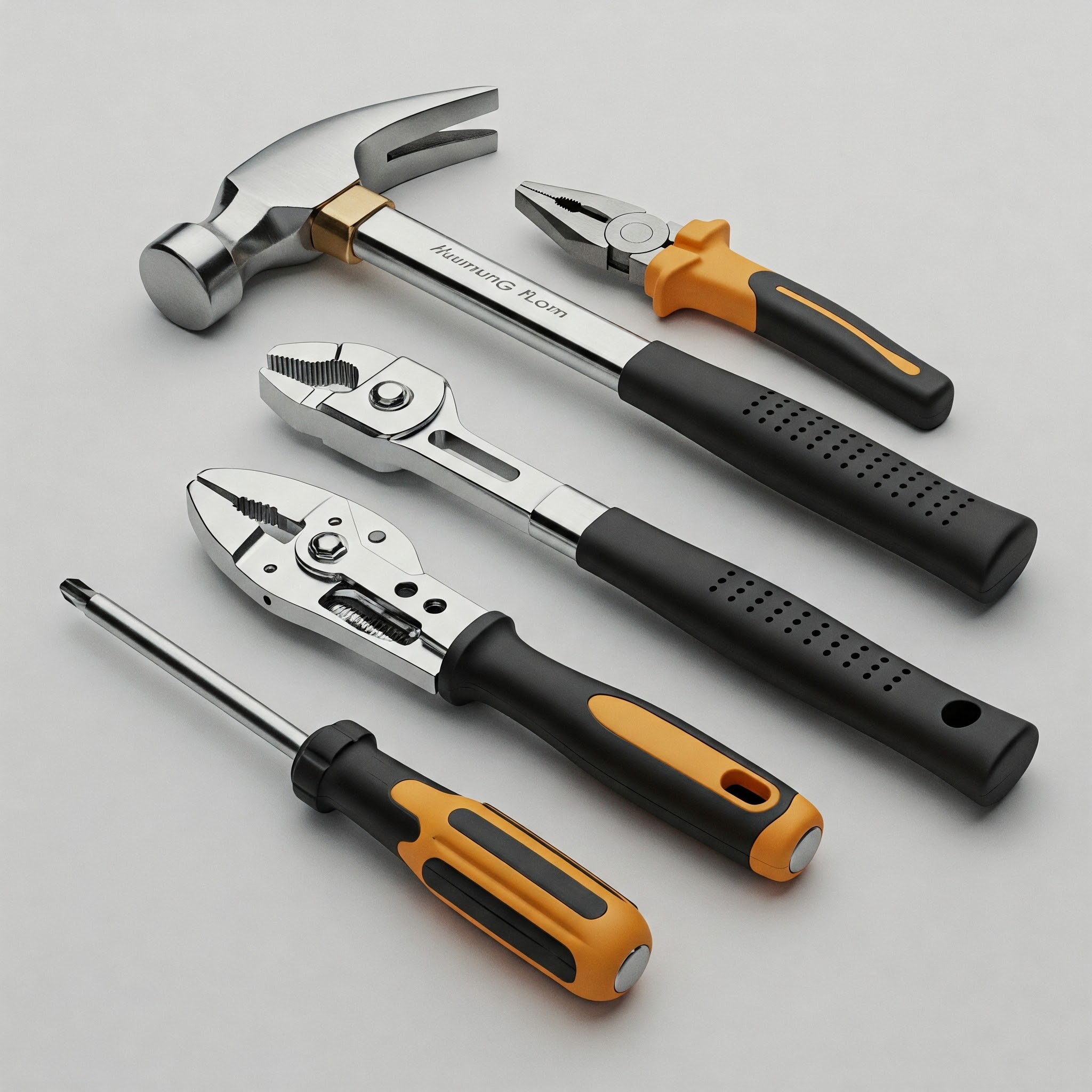Modern hand tools have undergone a remarkable transformation, driven by significant advancements in tool design. This journey spans from ancient civilizations to the present day. Hand tools have been crucial in various industries and our daily lives. Grasping their history and evolution is key to appreciating the modern tools we rely on.
The importance of modern hand tools cannot be overstated. They have transformed our work and interaction with the environment. Thanks to tool design innovation, these tools are now more efficient, durable, and user-friendly. This article will explore the captivating realm of hand tools, examining their history, evolution, and the role of tool design innovation in shaping modern hand tools.
Key Takeaways
- Modern hand tools have undergone significant transformations thanks to tool design innovation.
- Understanding the history and evolution of hand tools is essential to appreciating modern hand tools.
- Tool design innovation has improved the efficiency, durability, and user-friendliness of modern hand tools.
- Modern hand tools play a vital role in various industries and daily life.
- The evolution of hand tools is a testament to human ingenuity and the desire for improvement.
- Modern hand tools are designed to make work easier, faster, and more efficient.
The Historical Journey of Hand Tools
Hand tools have seen remarkable changes through the ages, driven by human creativity and technological progress. The evolution of new hand tools has been a slow yet steady journey. Each era has added its own layer to the development of tool design, materials, and functionality.
The history of hand tools is a captivating tale, filled with pivotal moments that have shaped the industry. Some of the most significant advancements include:
- Ancient civilizations’ use of primitive tools, such as hammers and chisels
- The Industrial Revolution’s introduction of mass production techniques and new materials
- Mid-20th century advances in tool design and technology, leading to the creation of new hand tools with improved ergonomics and performance
Exploring the historical journey of hand tools reveals a blend of innovation, experimentation, and adaptation. The evolution of tools through the ages has been a dynamic journey. Each era has built upon the discoveries and achievements of the past.
The story of hand tools showcases human creativity and determination. It underscores the role of innovation and progress in shaping our world. By delving into the historical journey of hand tools, we gain insight into the complex and intriguing process of tool development, spanning from ancient times to today.
| Era | Notable Developments |
|---|---|
| Ancient | Primitive tools, such as hammers and chisels |
| Industrial Revolution | Mass production techniques, new materials |
| Mid-20th century | Advances in tool design and technology, new hand tools with improved ergonomics and performance |
Understanding Modern Hand Tools in Today’s World
Modern hand tools have seen a major shift, thanks to tool design innovation and the use of advanced materials. This has led to a new era of modern hand tools that are not only more efficient but also durable and easier to use. Today’s users are looking for tools that can handle the fast pace of their tech-driven lives.
The variety of modern hand tools is vast, offering something for every profession and DIY enthusiast. These tools, ranging from precision instruments to heavy-duty equipment, are essential in our modern world. Key features of modern hand tools include:
- Advanced materials, such as titanium and stainless steel, for improved durability and resistance to corrosion
- Ergonomic designs, reducing fatigue and improving user comfort
- Integrated technologies, such as LED lights and laser guides, for enhanced precision and accuracy
As the need for modern hand tools keeps rising, manufacturers are coming up with innovative solutions. They focus on tool design innovation, ensuring the industry keeps evolving. This is driven by the latest in materials, technologies, and design.
| Tool Type | Features | Benefits |
|---|---|---|
| Precision Instruments | Advanced materials, ergonomic design | Improved accuracy, reduced fatigue |
| Heavy-Duty Equipment | Integrated technologies, durable construction | Enhanced productivity, increased efficiency |
Revolutionary Materials in Tool Manufacturing
The evolution of hand tools has been greatly influenced by materials science advancements. Innovations in tool design have resulted in stronger, lighter, and more durable tools. The introduction of materials like carbon fiber, advanced polymers, and composites has revolutionized the industry.
These new materials bring several benefits:
- They offer a higher strength-to-weight ratio, making tools easier to handle and more efficient.
- They resist corrosion and wear better, extending tool lifespan.
- They are more durable, reducing the need for frequent replacements and waste.
Carbon fiber components are increasingly used in hand tool production. Its exceptional strength, lightness, and resistance to fatigue make it ideal. Advanced polymers also play a key role, enabling the creation of complex shapes and structures previously unattainable.
The tool manufacturing industry is set to see even more innovative materials. These advancements will significantly impact tool efficiency and sustainability. We can expect tools that are not only more effective but also more environmentally friendly.
| Material | Properties | Benefits |
|---|---|---|
| Carbon Fiber | High strength-to-weight ratio, resistance to corrosion | Lighter, stronger, and more durable tools |
| Advanced Polymers | Complex shapes, resistance to fatigue | Improved tool performance, reduced waste |
| Composite Materials | Enhanced durability, resistance to wear | Longer tool lifespan, reduced maintenance |
Ergonomic Innovations Reshaping Tool Design
The evolution of modern hand tools highlights the critical role of ergonomics in their design. By examining tools through the ages, we uncover how understanding human factors has led to more comfortable tools. This shift emphasizes the importance of user experience in tool design.
Key aspects of ergonomic tool design include:
- Contoured handles for reduced fatigue
- Balance and weight distribution for ease of use
- Non-slip grips for improved control
These advancements stem from a blend of traditional wisdom and contemporary insights into user comfort. By focusing on ergonomics, manufacturers are crafting modern hand tools that are not only effective but also safe and pleasant to use.
The industry’s ongoing evolution promises even more groundbreaking designs that prioritize ergonomics and user experience. Embracing these innovations, we anticipate a future where tools through the ages are not only functional but also comfortable and safe.
Smart Technology Integration in Hand Tools
The integration of smart technology into hand tools is transforming our work environment. This tool design innovation brings about more precise and efficient tools. It’s a game-changer in various industries, offering a streamlined workflow and enhanced productivity.
Smart hand tools boast features like Bluetooth connectivity, digital measurement, and app-based management. These allow users to track tools, receive alerts, and access vital tool information via mobile devices. For example, workers can use apps to locate tools, simplifying inventory management and reducing losses.
The advantages of smart hand tools are vast. They offer better precision, increased efficiency, and improved maintenance. Digital measurements reduce errors, enhancing work quality. App-based management helps keep tools in top condition, ensuring they’re always ready for use.
Key Features of Smart Hand Tools
- Bluetooth connectivity for easy tool tracking and management
- Digital measurement capabilities for precise measurements
- App-based tool management for streamlined workflow and improved productivity
The inclusion of smart technology in hand tools marks a significant tool design innovation. It’s changing how we work. With new hand tools featuring smart tech, workers experience a more efficient and productive workflow. This leads to better outcomes and increased job satisfaction.
Sustainability and Eco-Friendly Tool Design
Exploring the evolution of modern hand tools reveals the critical role of sustainability in design. The industry is moving towards eco-friendly methods, using recycled materials and bioplastics. It’s also focusing on creating tools that last longer and can be recycled. This shift not only cuts down on waste but also lessens the environmental toll of tool production.
Looking back at tools through the ages, we see traditional practices that valued sustainability. Many ancient tools were made from local materials and built to be fixed or reused. This approach reduces the need for constant replacements. By applying these principles to modern hand tools, manufacturers can produce more eco-friendly products that cater to today’s users.
- Utilizing recycled materials in tool construction
- Adopting energy-efficient manufacturing methods
- Designing tools for easy repair and upkeep
By embracing these strategies, the industry can lessen its ecological footprint. It can also create modern hand tools that are both practical and sustainable.
As eco-friendly product demand rises, the tool industry must evolve to serve environmentally aware consumers. By focusing on sustainability in tool design, manufacturers can lower their environmental impact. They can also attract a broader customer base who values tools through the ages made with the planet’s well-being in mind.
Professional vs. DIY Modern Hand Tools
The distinction between professional and DIY hand tools is critical. Tool design innovation has created specialized tools for various tasks. Professionals need durable, precise tools, often made with advanced materials and ergonomic designs.
DIY enthusiasts, on the other hand, can find affordable tools for home workshops. The right tool depends on the task’s needs and the user’s skill level. Professionals value durability and precision, while DIYers look at price and performance.
Commercial Grade Innovations
Commercial tools boast cutting-edge technology, like advanced polymers and composites. These advancements improve tool performance, making them suitable for heavy-duty tasks. Brands like DeWalt and Milwaukee are leaders in professional-grade tools.
Home Workshop Solutions
DIYers can find affordable, entry-level tools that offer great value. Brands such as Black+Decker and Stanley provide tools for specific tasks. DIYers should look at ease of use, versatility, and cost when choosing tools.
Price-Performance Considerations
The choice between professional and DIY tools hinges on budget and needs. Users should weigh durability, precision, and cost to make informed decisions. The table below highlights the main differences between professional and DIY tools:
| Tool Type | Key Features | Price Range |
|---|---|---|
| Professional | Durable, precise, advanced materials | $50-$200 |
| DIY | Affordable, entry-level, versatile | $20-$100 |
Understanding the differences between professional and DIY tools helps users choose the best for their needs. This ensures efficient and effective work with their hand tools.
Safety Enhancements in Contemporary Tools
When it comes to modern hand tools, safety is paramount. Over the years, tools through the ages have evolved significantly. They now come equipped with various safety features, lowering the risk of accidents and injuries. Today, manufacturers focus on user safety, designing tools with ergonomic handles. These handles help prevent slip and fall accidents.
Some of the key safety enhancements in contemporary tools include:
- Advanced materials that minimize the risk of tool failure
- Improved grip designs that reduce the likelihood of tools slipping from the user’s hands
- Enhanced visibility features, such as LED lights, to illuminate work areas
These safety features highlight the evolution of modern hand tools. They have made significant strides since their inception. By integrating these safety enhancements, manufacturers have created a safer work environment. This is true for both professionals and DIY enthusiasts, regardless of whether they use tools through the ages or the latest innovations.
The Future of Hand Tool Innovation
Looking ahead, tool design innovation will remain crucial in the hand tool industry. Advances in materials science, AI, and IoT promise more advanced and user-friendly tools. New hand tools will emerge, driven by technologies like 3D printing and nanotechnology. These innovations will allow for the creation of complex, customized tools.
The fusion of tool design innovation and new hand tools will significantly influence consumer behavior and market demand. Consumers now seek tools that are not just functional but also sustainable and eco-friendly. Manufacturers must focus on developing tools that meet these criteria, ensuring they are affordable and accessible to many.
Emerging Technologies
- 3D printing and nanotechnology
- Artificial intelligence and machine learning
- Internet of Things (IoT) and connectivity
These emerging technologies will lead to the creation of more efficient, effective, and sustainable hand tools. For instance, 3D printing will enable the production of complex, customized tools. AI and machine learning will allow tools to adapt to various tasks and environments.
Predicted Design Trends
As the hand tool industry evolves, several design trends are expected to emerge. These include the use of sustainable materials, the integration of technology and connectivity, and the development of ergonomic, user-friendly tools. By focusing on tool design innovation and new hand tool development, manufacturers can stay ahead of consumer needs.
| Design Trend | Description |
|---|---|
| Sustainable Materials | The use of eco-friendly materials, such as recycled plastics and biodegradable metals |
| Technology Integration | The integration of technology, such as AI and IoT, into hand tools |
| Ergonomic Design | The development of tools that are designed to reduce fatigue and improve user comfort |
Embracing the Tool Evolution
The history of hand tools is a fascinating journey through time, filled with groundbreaking innovations and design improvements. These advancements have significantly changed how we work. From the early stone tools of our ancestors to today’s modern hand tools, the evolution is truly remarkable.
Understanding the rich history and continuous development of tools through the ages helps us value the tools we use today. Modern hand tools boast innovative materials, ergonomic designs, and smart technologies. This makes them more efficient, safer, and accessible than ever. Whether you’re a professional or a DIY enthusiast, embracing this evolution unlocks new possibilities and boosts productivity.
The future of hand tool innovation is vast and exciting. Emerging technologies, predicted trends, and changing consumer needs will drive the industry forward. Tools will become more intuitive, sustainable, and responsive to our evolving needs. By staying informed and embracing this evolution, we ensure our tools remain at the forefront of progress. This empowers us to handle any task with confidence and precision.


